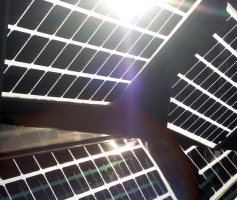Singapore
Find out what's in store at 10th Singapore International Energy Week
Theme will be "Rethinking Energy; Navigating Change".
Find out what's in store at 10th Singapore International Energy Week
Theme will be "Rethinking Energy; Navigating Change".
IoT in the power sector: Opportunities in Asia and the Pacific
Internet of Things (IoT) is billed as the next industrial revolution, Industry 4.0. The concept of IoT can be encapsulated as the capability to sense the environment with multitude of sensors, process all the data, make intelligent decisions and act in real time. At a high level there are three use-cases of IoT in the power sector: a) operational optimization resulting in improved economics and reduced carbon emissions, b) asset performance management (APM) for higher reliability and lower cost of maintenance, and c) customer engagement with the objective of lowering cost, and supporting local production, storage and usage of electricity.
Renewable Energy recipes III – tariffs for PV projects
Continuing my series on recipes for procedures to support Asia to develop PV capacity I am devoting this one to the tariffs. I mentioned on one of my earlier recipes that tariffs should be obtained from the market and FiT should be avoided or treated very carefully. I am now going to expand a bit on this issue. This recipe will require to consider 2 objectives:
How the private sector can use Myanmar's strategic environmental assessment
For emerging economies in Asia and beyond, ‘business as usual’ is no longer enough for hydropower development. Instead, transparency, inclusiveness, benefit sharing and environmental and social responsibility, are the key actions that stakeholders and project-affected communities are looking for when it comes to private sector operations. Likewise, investors exploring new opportunities in emerging markets want a clear understanding of their project’s environmental and social risks.
Cheaper solar pushes Thailand to rejig energy plan
Traditional power projects failed to meet deadlines.
Equis Energy is allegedly looking for bids for $4b power assets
The bids must be in by late September, sources said.
Solar power development in Southeast Asia
As renewables markets mature, renewables investors are looking to new markets for their next source of growth. Solar photovoltaic (PV) generation has great potential and has been the most attractive renewable energy source amongst the Southeast Asian nations. Annual solar radiation levels in the region ranges from 1,460 to 1,900 kWh/m2/per year. Growth prospects are tremendous in Southeast Asia with a combination of fast-growing economies with resulting investment in manufacturing, transportation and energy infrastructure, rapid growth in electricity demand and good solar resource.
Singapore's installed solar capacity reaches 129.8MW
Non-residential installations grabbed the lion's share of installed capacity.
Singapore's GIC eyes buying 31.7% stake in Philippines geothermal power producer
The deal could be worth up to $1.3b.
Engie in talks with developer Equis Energy to buy India portfolio
It mulls over buying Energon and Energon Soleq.
Where are the energy investment hotspots in Asia?
Myanmar stands out the most, according to OWL Energy's Tony Segadelli.
Are small modular reactors the way to go for Southeast Asia?
Post-Fukushima, nuclear energy remains a strategic option to address energy security and decarbonisation for developing economies, especially those in the ASEAN region. However, a Fukushima-scale accident occurring in ASEAN could lead to severe trans-boundary impacts to several ASEAN members due to close geographical proximity. ASEAN members are generally lacking in experience with nuclear energy albeit varied developments in nuclear safety, policy, and human infrastructure. The trans-boundary impacts due to a severe nuclear accident could cause catastrophic consequences in the region. With the lasting memories of Fukushima, the construction of large-sized reactors has become a highly sensitive and much disputed topic in ASEAN. The emergence of small modular reactors has somewhat revived the expectation of nuclear energy in the region.
Renewable Energy recipes II – feasible sites for PV projects
Continuing my series on recipes for procedures to support Asian countries in developing Renewable Energies, I am going to address the feasibility of sites for PV projects. One may think that it is obvious that some sites are not feasible: mountains, wetlands, rocky outcrops, coastal lines, water catchment areas and others. However the question then becomes are such types of sites really not feasible?
The era of battery-based energy storage is upon us
Will the traditional utility business model be disrupted?
Sembcorp nabs two rooftop solar facilities
They have a combined capacity of 2.3MW.
China's solar installations predicted to have surged in June
10-12GW of installations are expected.
Registration opens for the 10th Singapore International Energy Week
Find out what's in store for attendees.










 Advertise
Advertise


















